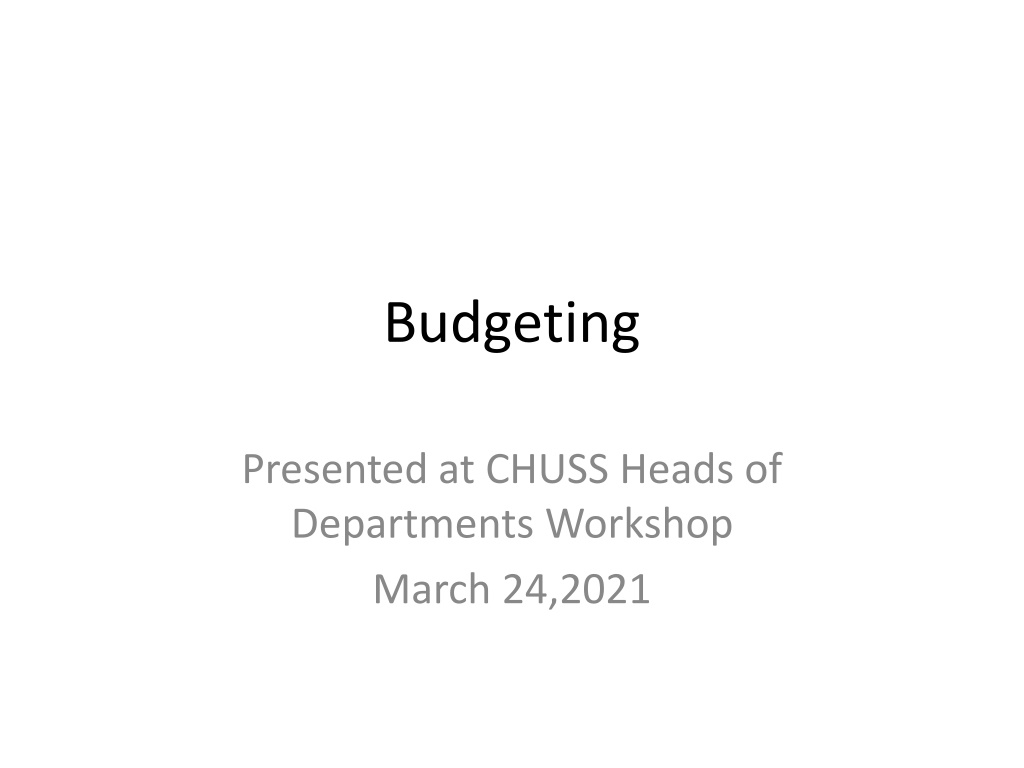Budgeting Essentials Presented at CHUSS Heads of Departments Workshop
Budgeting is a vital managerial process involving designing, implementing, and operating budgets to plan, coordinate, and ensure effective control over organizational activities to achieve objectives. This process includes incremental, activity-based, value proposition, and zero-based budgeting methods, with approaches such as top-down and bottom-up. The budgeting process encompasses planning, forecasting, implementation, monitoring, and evaluation to optimize financial management.
- Budgeting Essentials
- Managerial Process
- Organizational Control
- Incremental Budgeting
- Activity-Based Budgeting
Download Presentation

Please find below an Image/Link to download the presentation.
The content on the website is provided AS IS for your information and personal use only. It may not be sold, licensed, or shared on other websites without obtaining consent from the author. Download presentation by click this link. If you encounter any issues during the download, it is possible that the publisher has removed the file from their server.
E N D
Presentation Transcript
Budgeting Presented at CHUSS Heads of Departments Workshop March 24,2021
Out line Definition Purpose/Objective Types/Budgeting Approaches Process/Cycle Conclusion
Definition/ Meaning Budgeting is a process of designing, implementing and operating budgets. It is the managerial process of budget planning and preparation, budgetary control and the related procedures. A budget is an estimation of revenue and expenses over a specified future period of time
Purpose/Objective The overall purpose of budgeting is to plan coordinate ensure effective control over activities of an organization to achieve its objectives.-CERTL
Types of Budgets/Budgeting Methods Incremental budgeting Incremental budgeting takes last year s actual figures and adds or subtracts a percentage to obtain the current year s budget. Its most appropriate where cost do not change from year to year It is likely to perpetuate inefficiencies.-growth the budget It is likely to result in budgetary slack-Always within the budget It is also likely to ignore external drivers of activity and performance-Inflation Activity-based budgeting Activity-based budgeting is a top down budgeting approach that determines the amount of inputs required to support the targets or outputs set by the company. Value proposition budgeting In value proposition budgeting, the budgeter considers the following questions: Why is this amount included in the budget? Does the item create value for customers, staff, or other stakeholders? Does the value of the item outweigh its cost? If not, then is there another reason why the cost is justified? Zero-based budgeting starts with the assumption that all department budgets are zero and must be rebuilt from scratch. Managers must be able to justify every single expense. No expenditures are automatically okayed
Approaches to Budget process Two approaches Top-down approach Involves senior management preparing budgets based on organizational objectives. Advantage- Saves time for junior managers Bottom-up approach This approach starts at the departmental level and moves up to higher levels. Disadvantage- Time consuming lengthy and time-consuming. Advantage Employees and managers are more motivated to achieve the budget goals since they have prepared it. They have the complete knowledge of what the budget actually expects them to do and how to achieve that. Such budgets tend to be more accurate and closer to the actual situation on the ground.
Budget Process/Cycle The budgeting process is the process of putting a budget in place. This process involves Planning Forecasting implementing, monitoring and controlling, and finally evaluating the performance of the budget.
Budget Cycle Budget Formulation Budget Approval Budget Execution Budget Oversight
Budget Formulation Step 1: Identify Your Goals. ... Step 2: Review What You Have. ... Step 3: Define the Costs. ... Step 4: Create the Budget.
Budget Approval The budget will then go to the top management for approval. They will check if it is proper. Makers will make any changes as per need. In case everything is fine with the budget, they will give the go-ahead for implementation.
Budget Execution Is the process by which the financial resources made available to an agency are directed and controlled toward achieving the purposes and objects for which budgets were approved. The process involves compliance with both legal and administrative requirements.
Budget Oversight The budget accounts are audited and the audit findings are reviewed by the legislature, which requires action to be taken by the executive to correct audit findings
























